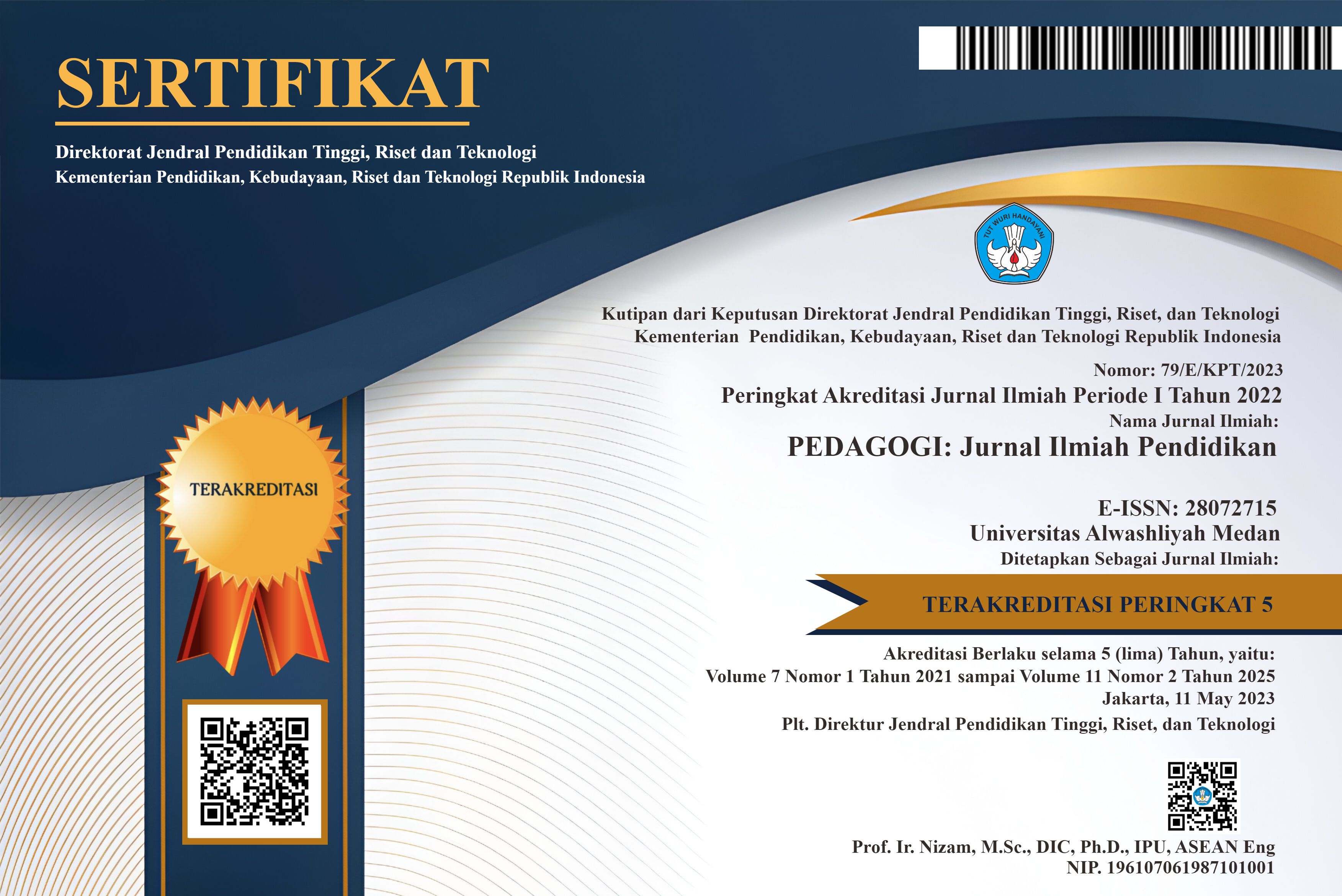HUBUNGAN TINGKAT AKTIVITAS FISIK, DENGAN STRESS,DEPRESI DAN KECEMASAN SISWA REMAJA USIA 17– 19 TAHUN DI SMA AL-ISLAM KRIAN
DOI:
https://doi.org/10.47662/pedagogi.v11i1.1043Kata Kunci:
physical activity, stress, depression, anxiety, adolescentsAbstrak
Physical activity plays an important role in adolescents' mental health. Increased activity can help reduce levels of stress, depression, and anxiety. This study aims to analyse the relationship between physical activity levels and mental health conditions in 220 students of Al-Islam Krian High School with an age range of 17 to 19 years, consisting of 70 male students (30%) and 150 female students (70%). This research design uses quantitative descriptive method through observation. The instruments used were the International Physical Activity Questionnaire Short Form (IPAQ SF) to measure physical activity levels and the Depression Anxiety Stress Scale 21 (DASS 21) to assess stress, depression, and anxiety. The results showed that 10% of students had low physical activity, 59% were moderate, and 31% were high. Data were analysed using SPSS 29 with the significance results of stress (p = -0.067), depression (p = -0.044), and anxiety (p = -0.031). Based on correlational analysis, it was found that there was no significant relationship, but it was negative. This means that the higher the physical activity, the lower the levels of stress, depression, and anxiety. Physical activity does not directly play a role in mental health factors, but has a tendency to reduce stress, depression, and anxiety in adolescents.
Referensi
Ali, A. M., Hori, H., Kim, Y., & Kunugi, H. (2022). The Depression Anxiety Stress Scale 8-Items Expresses Robust Psychometric Properties as an Ideal Shorter Version of the Depression Anxiety Stress Scale 21 Among Healthy Respondents From Three Continents. Frontiers in Psychology, 13. https://doi.org/10.3389/fpsyg.2022.799769
Anderson, E., & Shivakumar, G. (2013). Effects of Exercise and Physical Activity on Anxiety. Frontiers in Psychiatry, 4. https://doi.org/10.3389/fpsyt.2013.00027
Bachtiar, F., Condrowati, C., Purnamadyawati, P., Anggraeni, D. T., Larasati, K., Meilana, A. S. B., & Fadilah, N. (2023). Hubungan antara Aktivitas Fisik dengan Kesehatan Mental Remaja di Masa Pandemi Covid-19. Malahayati Nursing Journal, 5(2), 503–514. https://doi.org/10.33024/mnj.v5i2.7982
Bell, S. L., Audrey, S., Gunnell, D., Cooper, A., & Campbell, R. (2019). The relationship between physical activity, mental wellbeing and symptoms of mental health disorder in adolescents: a cohort study. International Journal of Behavioral Nutrition and Physical Activity, 16(1), 138. https://doi.org/10.1186/s12966-019-0901-7
Buecker, S., Simacek, T., Ingwersen, B., Terwiel, S., & Simonsmeier, B. A. (2021). Physical activity and subjective well-being in healthy individuals: a meta-analytic review. Health Psychology Review, 15(4), 574–592. https://doi.org/10.1080/17437199.2020.1760728
Dinger, M. K., Behrens, T. K., & Han, J. L. (2006). Validity and Reliability of the International Physical Activity Questionnaire in College Students. American Journal of Health Education, 37(6), 337–343. https://doi.org/10.1080/19325037.2006.10598924
Febriana, P., & Situmorang, N. Z. (2019). Mengapa remaja agresi? Jurnal Psikologi Terapan Dan Pendidikan, 1(1), 16. https://doi.org/10.26555/jptp.v1i1.15128
Harahap, T. K., P, I. M. I., Issabella, C. M., Hasibuan, S., Yusriani, Hasan, M., Musyaffa, A. ., Surur, M., & Ariawan, S. (2021). METODOLOGI PENELITIAN PENDIDIKAN (U. Khasanah (ed.)). TAHTA MEDIA GROUP. https://repository.uinmataram.ac.id/1064/1/Book chapter_Metopen.pdf
Junindra Cahya Negara, Hamidie, A., & Paramitha, S. T. (2024). Pengaruh Aktivitas Fisik dan Perilaku Sedentari pada Kesehatan Mental Anak-anak. JURNAL PENDIDIKAN OLAHRAGA, 14(3), 127–135. https://doi.org/10.37630/jpo.v14i3.1655
Lubans, D., Richards, J., Hillman, C., Faulkner, G., Beauchamp, M., Nilsson, M., Kelly, P., Smith, J., Raine, L., & Biddle, S. (2016). Physical Activity for Cognitive and Mental Health in Youth: A Systematic Review of Mechanisms. Pediatrics, 138(3). https://doi.org/10.1542/peds.2016-1642
Oktaviana, W. I., Bayu, W. I., & Yusfi, H. (2022). Hubungan Antara Aktivitas Fisik Terhadap Tingkat Kecemasan. Jurnal Ilmu Keolahragaan Undiksha, 10(2), 162–168. https://doi.org/10.23887/jiku.v10i2.44115
Schutte, N. M., Nederend, I., Hudziak, J. J., de Geus, E. J. C., & Bartels, M. (2016). Differences in Adolescent Physical Fitness: A Multivariate Approach and Meta-analysis. Behavior Genetics, 46(2), 217–227. https://doi.org/10.1007/s10519-015-9754-2
Sember, V., Meh, K., Sorić, M., Starc, G., Rocha, P., & Jurak, G. (2020). Validity and Reliability of International Physical Activity Questionnaires for Adults across EU Countries: Systematic Review and Meta Analysis. International Journal of Environmental Research and Public Health, 17(19), 7161. https://doi.org/10.3390/ijerph17197161
Sierra-Díaz, M. J., González-Víllora, S., Pastor-Vicedo, J. C., & López-Sánchez, G. F. (2019). Can We Motivate Students to Practice Physical Activities and Sports Through Models-Based Practice? A Systematic Review and Meta-Analysis of Psychosocial Factors Related to Physical Education. Frontiers in Psychology, 10. https://doi.org/10.3389/fpsyg.2019.02115
Sirajudeen, M. S., Waly, M., Manzar, M. D., Alqahtani, M., Alzhrani, M., Alanazi, A., Unnikrishnan, R., Muthusamy, H., Saibannavar, R., & Alrubaia, W. (2022). Physical activity questionnaire for older children (PAQ-C): Arabic translation, cross-cultural adaptation, and psychometric validation in school-aged children in Saudi Arabia. PeerJ, 10, e13237. https://doi.org/10.7717/peerj.13237
Sugiyono. (2013). Metode Penelitian Pendidikan Pendekatan Kuantitatif, Kualitatif dan R&D. Bandung: Alfabeta.
Suriani, N., Risnita, & Jailani, M. S. (2023). Konsep Populasi dan Sampling Serta Pemilihan Partisipan Ditinjau Dari Penelitian Ilmiah Pendidikan. Jurnal IHSAN : Jurnal Pendidikan Islam, 1(2), 24–36. https://doi.org/10.61104/ihsan.v1i2.55
Tajik, E., Abd Latiff, L., Adznam, S. N., Awang, H., Yit Siew, C., & Abu Bakar, A. S. (2017). A study on level of physical activity, depression, anxiety and stress symptoms among adolescents. The Journal of Sports Medicine and Physical Fitness, 57(10). https://doi.org/10.23736/S0022-4707.16.06658-5
Tarik, P., Prambon, P., Krembung, P., Porong, P., Kedungsolo, P., Jabon, P., Tanggulangin, P., Candi, P., Tulangan, P., Kepadangan, P., Wonoayu, P., Sukodono, P., Sidoarjo, P., Urangagung, P., Buduran, P., Sedati, P., Waru, P., Medaeng, P., Gedangan, P., … Keluarga, S. K. (2018). PROFIL KESEHATAN KABUPATEN SIDOARJO TAHUN 2018.
Usmadi, U. (2020). PENGUJIAN PERSYARATAN ANALISIS (UJI HOMOGENITAS DAN UJI NORMALITAS). Inovasi Pendidikan, 7(1). https://doi.org/10.31869/ip.v7i1.2281
Zou, R., Wang, K., Li, D., Liu, Y., Zhang, T., & Wei, X. (2024). Study on the relationship and related factors between physical fitness and health behavior of preschool children in southwest China. BMC Public Health, 24(1), 1759. https://doi.org/10.1186/s12889-024-19269-0
Unduhan
Diterbitkan
Cara Mengutip
Terbitan
Bagian
Lisensi
Hak Cipta (c) 2025 Roihan Ramadhan, Pudjijuniarto Pudjijuniarto, Dita Yuliastrid, Roy Januardi Irawan

Artikel ini berlisensi Creative Commons Attribution-NonCommercial 4.0 International License.





